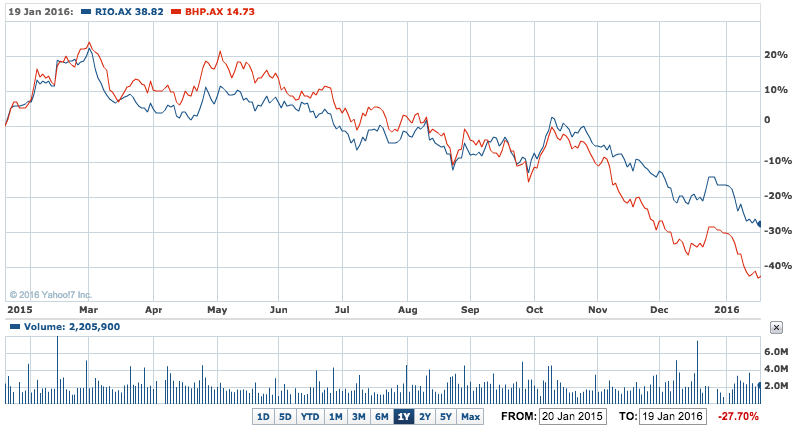Rio Tinto’s (RIO) solid 4th quarter and full year production report suggests that for the next few months at least it is in a better place than rival BHP Billiton (BHP).
But like BHP, Rio does face a tough question on the future of its dividend when it reports its full year financial results midway through next month.
BHP will report a loss for the year, including the $US7.2 billion ($A10 billion) write-off of value from its US shale oil and gas assets.
BHP reports its December quarter and half year production and sales figures today.
Rio Tinto paid out $US3.7 billion in dividends in 2014, should be able to maintain that level for 2015, but come August when it reports its interim, it will be under pressure to justify continuing it beyond without straining its balance sheet.
Rio paid an interim dividend last year of $US1.075 cents a share, up from 96 US cents for the first half of 2014. It paid a final dividend for 2014 of $US1.19 a share and a total dividend for 2014 as a whole of $US2.15 a share (up from $US196 in 2013).
Analysts reckon Rio will pay final and full year dividends similar to those paid a year ago. But it will have to cut the interim later this year because of the constraints from lower commodity prices, especially for iron ore and copper.
In BHP’s case it means that this year it would have to borrow to fund a payout of at least $US6.5 billion, the sum it paid out for the year to June 2015, if it sticks to its ‘progressive’ policy.
BHP vs RIO 1Y – Is Rio Tinto better positioned than BHP?

While Rio lifted production and shipments in the December quarter and for 2015 as a whole, falling iron ore prices carved a hole in its revenues.
Rio said its iron ore sales from its huge Pilbara mines rose 10% to 260.3 million tonnes in the year to December (318.5 million in total, including the share of partners in joint venture mines).
Total global iron ore exports met guidance of 340 million tonnes (includes operations in Canada). And the slowdown in demand expected this year and the weak global market can be seen from the forecast small rise for 2016 in global shipments to 350 million tonnes, with most of that coming from the Pilbara mines.
Buried in the report was a detail which shows the extent of the pain the price slide is causing to Rio’s finances. Rio said its average per tone price (on a wet basis) was $US48.40 a tonne, which is close to half the $US84.30 a tonne for 2014.
The size of the price fall wasn’t offset by the rise in sales last year and gross revenues for the Pilbara mines was $US12.598 billion, nearly $US7 billion down on the $US19.515 billion in revenue in 2014. That’s a big hole in the revenue, profits and cash flow for the group.
“Against a challenging market backdrop for the industry, Rio Tinto remains focused on operating and commercial excellence to leverage the low-cost position of our Tier 1 asset base," chief executive Sam Walsh said in a statement yesterday.
"We will continue to focus on disciplined management of costs and capital to maximise cash flow generation throughout 2016."
Hard coking coal production rose 11% for the year to 7.86 million tonnes, although semi-soft coking and thermal coal production was flat at 22.3 million tonnes.
Bauxite production was up 4% in 2015 to 43.7 million tonnes, while copper production dropped 16% to 504,400 tonnes and undershot the company’s forecast.
Aluminium has been Rio’s second biggest profit maker over the past 18 months, and the company easily met full-year guidance.
But copper is the company’s big hope for the future, and the company missed its full year target of 510,000 tonnes of mined copper after producing 504,000.
Rio shares rose 0.3% to $38.82 yesterday, while BHP shares were up 0.6% to $14.73 yesterday.













